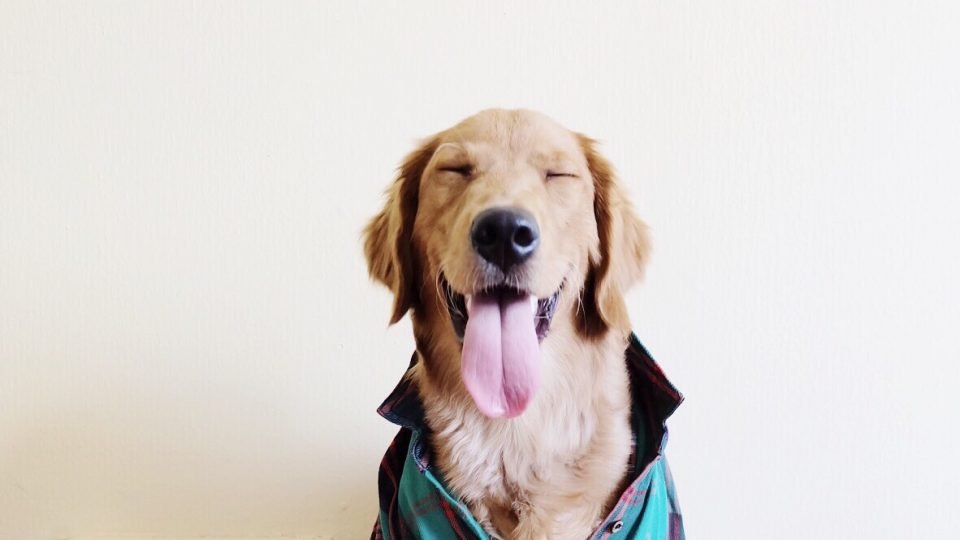How do you know when your dog is happy? Maybe it’s the way they wag their tail, or how they zoom around the room when you come home. If you’re like me, you probably just know your dog is happy, but you can’t quite explain how you know.
Dogs feel emotions similar to ours, but they can’t express them like we do. They show their feelings through body language, behaviour, and even health. And believe it or not, there are specific signs that indicate dog happiness.
Read on to learn how dogs show emotions, and how to tell when your dog is happy.
How dogs feel (and show) emotions
https://www.instagram.com/p/BaVsWliA-GC/?tagged=emotionaldog
Dogs have the emotional capacity of a 2 to 2.5-year-old child, meaning they experience emotions like joy, fear, and anger. In fact, dogs have the same hormones and undergo the same types of chemical changes that humans do during emotional shifts (source.)
Like a 2-year-old child, your dog lacks the vocabulary to tell you how they feel. However, also like a toddler, dogs’ body language and behaviour communicate emotions. For example, most of us know what it looks like when our dog is “frustrated.”
For my dog Ralph, frustration manifests as barking, or “talking” to me in plaintive whines. Her frustrated bark is quite different from her happy bark!
Physical signs of a happy dog
https://www.instagram.com/p/BYra69_D8rY/?tagged=tummyup
In general, a happy dog will have relaxed body language. These are some of the physical signs of a happy dog:
- A soft, partially open mouth
- Ears that are relaxed, not pulled back or taut with alertness
- Overall relaxed posture, with a raised head, relaxed tail, and confident stance (click here for more on dog body language)
- A tail wag that involves whole-body wiggles, or at least a relaxed body. Conversely, a dog standing stiffly with a tautly waving tail may be showing alertness or nervousness.
- Rolling over to show their belly
- Making a “play bow,” with their rear in the air and chest lowered to the ground as an invitation to play
Of course, every dog is different, and body composition may vary. But in general, a happy dog will appear comfortable and at ease.
Behavioural signs of a happy dog
https://www.instagram.com/p/2So7CeNLir/?tagged=leaningdog
In addition to body language cues, there are behavioural signs of happiness in dogs:
- Happy dogs are generally not destructive. Destructive behaviour can be a sign of anxiety or stress.
- They’re happy to play, take a walk, or go for a drive in the car. If your dog is uninterested in play time, they may be feeling unwell or in pain.
- They have a healthy appetite, which indicates feeling physically well and emotionally content. Changes in appetite are one of the first signs of potential illness or unhappiness.
- They lean into your hand or body. Happy dogs make a lot of body contact!
- They’re excited to see you when you walk in the door.
Factors like breed, age, and health can impact your dog’s behaviour. And of course, your dog’s baseline personality plays a role in how they express happiness!
You probably what your dog’s variations on “happy behaviours” look like, so your own list may look a bit different than the one above.
How to make your dog even happier
https://www.instagram.com/p/BbS8Qxyn2ab/?tagged=smilingdog
The best way to keep a dog happy is to simply provide for their physical, intellectual, and emotional needs. Make sure they have a healthy diet, an appropriate amount of exercise, enough mental stimulation, and lots of love and affection. If for whatever reason you can’t be around for your dog as much as you’d like, you can find lots of amazing sitters who’d be happy to keep them company and who provide dog boarding on Rover.com.
Another way to ensure your dog’s happiness is to look after your own! in addition to experiencing emotions of their own, dogs react to our moods. The healthier and more content you keep yourself, the more comfortable and content your dog will be, too. Learn more about how dogs react to human emotions here.
Finally, remember that “happiness” is just one of many emotions your dog is capable of feeling. It’s important to pay attention to your dog’s emotional cues, as changes in body language or behaviour may indicate emotional stress, physical discomfort, or illness. But it’s also important to allow for variations in mood.
After all, everybody gets cranky once in a while. As long as your dog is generally healthy, comfortable, and cared for, you can rest assure they’re happy, no matter how they show it.



